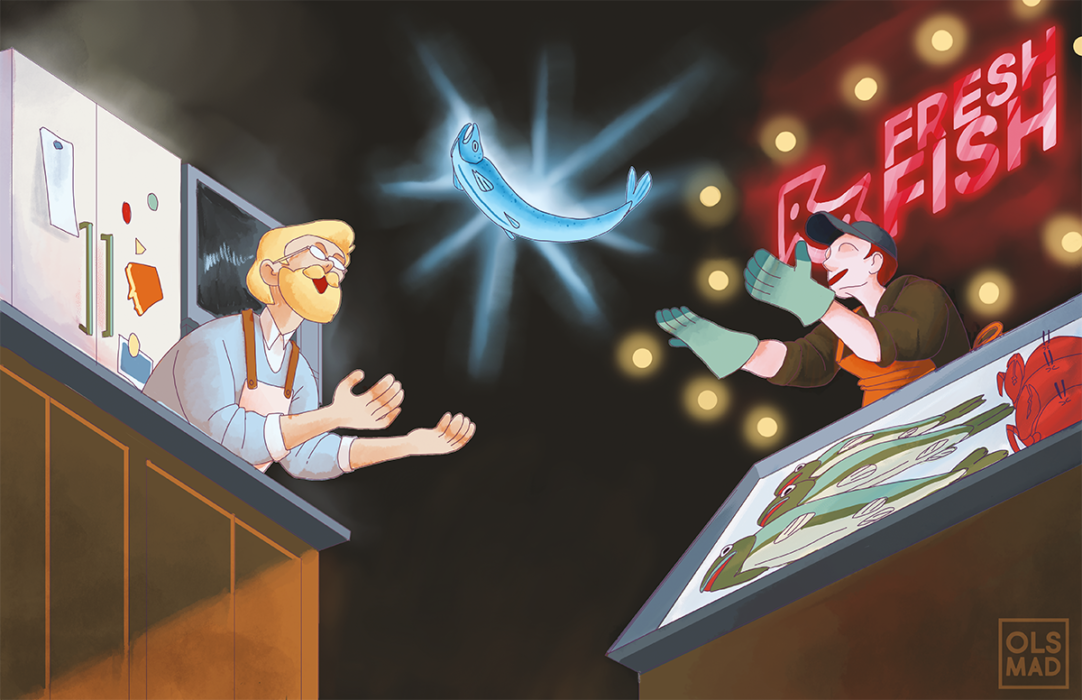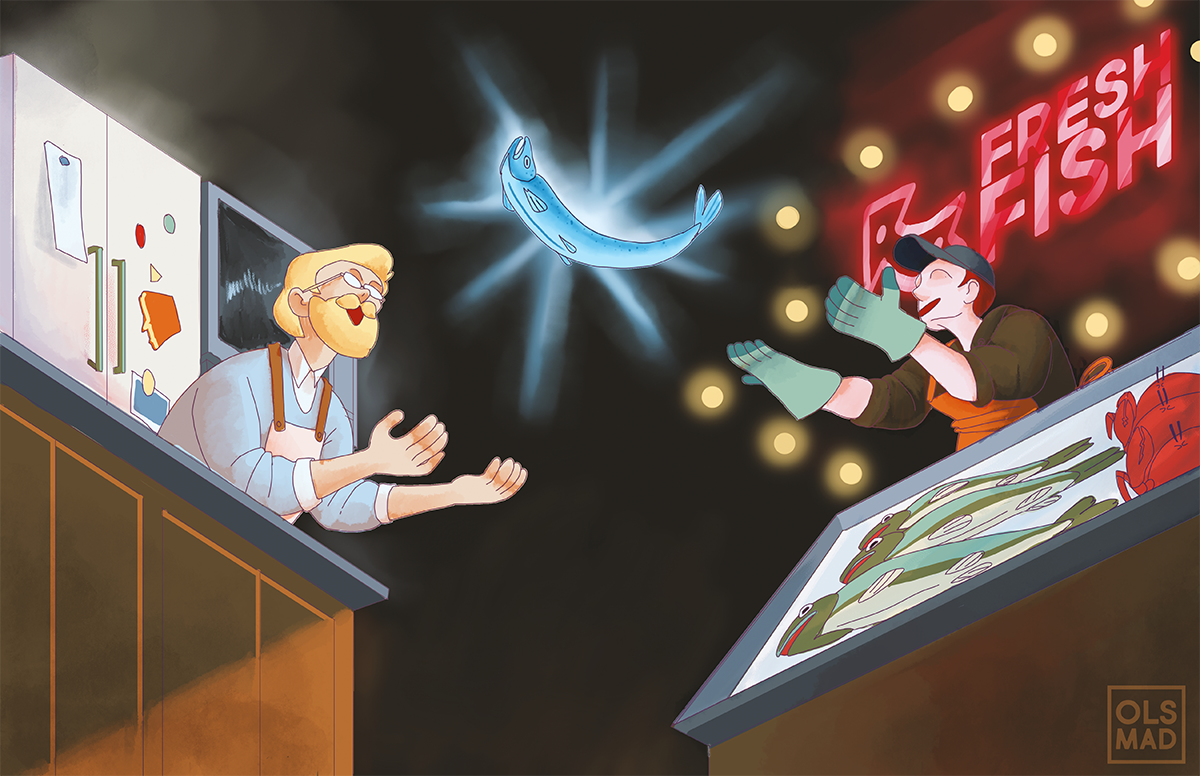
This story was produced with support from the Solutions Journalism Network, a nonprofit organization dedicated to rigorous and compelling reporting about responses to social problems.
Sporting a salt-and-pepper beard and a “Do Better” t-shirt, fisher Brian Trotter unloaded his black rockfish catch shortly after noon on a blindingly sunny August Friday. The Oregon port town of Garibaldi seemed almost normal that day. Scattered visitors milled about the village of 800 residents, eating lunch and buying albacore tuna off the dock. It was nothing like the ghost-town days of spring, when the boat launch shut down, businesses shuttered, and roads were desolate.
In the wake of COVID-19, Trotter’s business has been anything but usual. He would typically sell the majority of his 300-pound daily rockfish limit to a local fish-and-chips eatery, but when restaurants closed in response to the pandemic, demand for fresh seafood plummeted. In addition, the global conveyor belt that moves seafood from the Pacific Northwest to the rest of the world has sputtered as West Coast seafood processors battle COVID-19 outbreaks and international trade remains volatile. All the while, freezers fill with unsold fish that will drive down future prices.
But Trotter and other nimble fishers in the area are adjusting to this new reality. Their goal: creating more opportunities to get seafood to regional consumers. Some of Trotter’s catch is delivered to customers through a community-supported fishery, a program similar to the subscription-based produce boxes offered by local farms. In addition, he teamed up with a Garibaldi shellfish operation that sells his goods under the same brand at retailers specializing in local produce and seafood. With experiments like these, small-scale fishers like Trotter are seizing on an opportunity afforded by the crisis to create a stronger regional seafood system.
With seagulls shrieking overhead, Trotter shared some advice his mentor offered soon after COVID-19 became a pandemic: “Everybody’s going to have to change. If anyone is waiting for things to come back to the way it was, they are going to lose.”
Fishermen live with uncertainty and boom-bust cycles, but this pandemic is unsettling even the most stalwart. “I’ve never seen anything that rivaled this,” Port of Garibaldi Commissioner Bob Browning said. In March, more than 80 seafood industry executives asked government officials for billions of dollars in aid spending. They noted the vast majority of restaurant spending, which accounts for roughly 70 percent of the $100 billion domestic seafood market, “evaporated overnight.”
But the evaporation of one market led some to consider others. “The ones that have gained in this crisis seem to be small-scale fishers who are able to sell direct,” said Jana Hennig, executive director of Positively Groundfish, a trade organization that promotes the often overlooked recovery of West Coast rockfish, sole, and sablefish.
Amid the pandemic, fishers, restaurants, and distributors are experimenting with direct-to-consumer sales, community-supported fisheries, meal kits, and flash-frozen, vacuum-sealed offerings. “We have the opportunity to invest in each other and build the food system we want,” said Kristen Penner, a Garibaldi-based crabber.
Penner is a former restaurateur who now owns Blue Siren Shellfish and a small processing operation; she sells some of Trotter’s rockfish. She has spent the last few years working with a coalition of state and city agencies, nonprofits, and the local fishing community to craft a vision for a vibrant, sustainable seafood hub in northwest Oregon.
“We live in one of most abundant places in the nation in terms of what we can produce,” she said. Yet it can be frustratingly difficult for consumers to get local seafood. The seafood supply chain is designed for size: big fishing operations work with big processors, who deliver goods to big retailers and distributors. In Garibaldi, for instance, there is a lack of infrastructure — hoists, dry storage, ample freezer space, and the like — to support small operations.
Realizing that seafood sustains tourism, the Oregon Coast Visitors Association plans to spend between $300,000 and $400,000 on forklifts and cold-storage equipment at the Garibaldi dock, business development support, and marketing of local seafood. So far, the OCVA has spent $52,000 on dock infrastructure in Garibaldi.
“You can get a burger anywhere, but people come to the Oregon coast for seafood,” said OCVA Executive Director Marcus Hinz. “We want more restaurants serving seafood and more fish markets — because those will increase the visitor experience.”
In the near term, though, that experience might take place in consumers’ kitchens. In pre-coronavirus times, Newport, Oregon restaurant Local Ocean Seafoods was known for its dock-to-table offerings. Owner Laura Anderson would buy seafood from as many as 50 different boats in a typical year. To buffer the decrease in restaurant sales, she introduced DockBox, a seafood meal kit with all the fixings available to customers in Newport, Portland, and Corvallis.
With dine-in traffic at a fraction of normal, restaurateurs saw that they needed to meet consumers where they’re most comfortable, Anderson said. But seafood has long been eschewed by home chefs. For one, it can be expensive, and most people are unfamiliar with how to properly cook it. “I know a lot of people in the industry have been working towards making it easier for people to cook seafood at home. DockBox is part of that,” Anderson said.
While restaurants are struggling, retailers are seeing a spike in demand. Since COVID-19 hit, sales have tripled at Tillamook, Oregon-based Food Roots, executive director Lauren Sorg said. Food Roots is a nonprofit that distributes local produce and seafood, including Trotter’s and Penner’s catches. To keep up with demand, and do so safely, the organization recently opened an online marketplace. “COVID disrupted normal buying habits,” said Sorg. It’s part of a nationwide trend; retail sales of seafood have jumped around the country since the pandemic started.
To encourage adventurous home chefs, Oregon Sea Grant, an Oregon State University program that promotes coastal community resilience, has created downloadable recipe cards for dishes from local chefs. It’s also educating consumers that frozen and vacuum-sealed fish tastes as good, if not better, than previously frozen fish sold as “fresh” at many seafood counters.
“We are trying to demystify seafood,” said Angee Doerr of Oregon Sea Grant.
Tele Aadsen and her husband, Joel Brady-Power, were relieved to see just how adventurous consumers could get. The Bellingham, Washington-based duo run Nerka Sea-Frozen Salmon. They fish for king and coho salmon each summer in Alaska, and their catch is flash-frozen within one hour, right on the boat. Like Trotter, Aadsen and Brady-Power had to pivot from restaurant sales to direct-to-consumer under duress this spring.
“One thing fellow fishermen always say is, ‘Oh, individual consumers won’t deal with a whole fish’. But that wasn’t our experience,” said Aadsen. “People were excited to have whole fish and learn how to filet or smoke it themselves because they have the time to do something new.”
Bob Eder, who catches crab and sablefish — also known as black cod — out of Newport, is happy that Americans are learning to prepare and eat seafood at home, but “there’s no way that will make up for the loss of demand,” he said. After all, the direct-to-consumer model is a nice option only for smaller operations, not for larger vessels.
“If we average between 30,000 and 40,000 pounds of black cod every time we go fishing, we can’t go to the Saturday market with that,” Eder said. And if there’s too much Dungeness crab sitting in the freezer at the end of summer, he will face abysmal winter prices.
“It’s going to be years, not months, that are tough,” Eder predicted.
It’s already been rough for seafood processing plants large and small. High Tide Seafoods, on Washington’s Olympic Peninsula, has seen its revenue decline by half over the last six months, manager Dan Schleve said. Pacific Seafoods and Bornstein Seafoods — two of the largest processors on the West Coast — closed their facilities for a period after workers tested positive for the coronavirus.
Some hope COVID-19 will reverse ills that emerged after two decades of seafood industry consolidation on the West Coast. Fewer processors left the big players with tremendous pricing power, so fishermen have had to maximize volume to sustain a livelihood, explained Mike Domeyer of Tre-Fin Day Boat Seafood in Ilwaco, Washington. Over time, he said, a system emerged that essentially holds onto fish until distributors can drop it in the market when it commands the highest prices.
Domeyer’s operation shows a different path forward. Six years ago, Tre-Fin started selling both wholesale and as a community-supported fishery, in which fishermen could sell direct to consumers — much like community-supported agriculture, or CSA, operations. About eight local fishers, including Trotter, currently sell their seafood direct to consumers through Tre-Fin.
“We were uniquely positioned when COVID hit,” Domeyer said. Tre-Fin’s revenue is up 65 percent year-to-date compared with 2019, largely due to the COVID-19-related shifts in buying habits.
“We always dreamed the general public would gain an interest in where their food came from—and we’d be there, with an open-book story,” he said.
Domeyer believes greater emphasis on nearby consumers would make the entire Northwest fishing supply chain more resilient. Nancy Fitzpatrick, executive director of the Oregon Albacore Commission and the Oregon Salmon Commission, agrees. “Our mission is to keep [our fish] domestic,” she said. Some fisheries are trending in that direction. A decade ago, 90 percent of Oregon’s albacore tuna was shipped out of the region; today, Fitzpatrick said, half the catch ends up on Northwest plates.
One reason that’s possible is that albacore isn’t regulated the way many other fisheries are, especially around Garibaldi. Nearly all of this small port’s most valuable fisheries — albacore notwithstanding — use limited entry models that employ individual fishing quotas. This system allows for closer regulation of fisheries, but can breed consolidation as companies buy up more quotas, which can be traded. So instead of numerous boats catching a few fish, a small number of vessels bring in large hauls, which limits the practicality of direct-to-consumer models.
“Why is our quality seafood going out to foreign countries, and our consumers can’t find it half the time?” Fitzpatrick said. At the same time, America imports seafood from countries with less-stringent regulations. “That just irks me no end,” she said.
COVID-19 has some of the big players rethinking things. Recently, a fisher on larger Garibaldi vessels expressed to Trotter his interest in direct-to-consumer and selling closer to home without as many steps in the supply chain. “What that meant to me is that somebody who has been fishing his whole life doesn’t want to be reliant on overseas markets to get their price,” Trotter said.
Although COVID-19 brought tremendous challenges, said Penner, the increased interest in local food is a lifeline for small-scale fishers eager to provide it.

